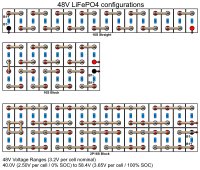I will be adding a double DIY LifePO4 battery with 15S and using 2 pcs. JK-B2A24S20P BMS.
Couple of weeks until the BMSs is here (ordered one more as backup...)
Bought cells through Qishou - EU warehouse delivery.
Planning to use EVE 280K, 30 pcs. 2 banks of 15S.
This is to be an extension to my existing pack with 4 x 200ah (same 15S 48V config), need more storage.
Also the reason for 15S to ensure the same 48V nominal instead of going with 16S 51.2V.
I am not a huge fan of the current raised price level on these things compared to a year or two since but what can you do...
I will add to this thread when stuff happens and product appears ^^.
There WILL be pictures.
Couple of weeks until the BMSs is here (ordered one more as backup...)
Bought cells through Qishou - EU warehouse delivery.
Planning to use EVE 280K, 30 pcs. 2 banks of 15S.
This is to be an extension to my existing pack with 4 x 200ah (same 15S 48V config), need more storage.
Also the reason for 15S to ensure the same 48V nominal instead of going with 16S 51.2V.
I am not a huge fan of the current raised price level on these things compared to a year or two since but what can you do...
I will add to this thread when stuff happens and product appears ^^.
There WILL be pictures.
Last edited:



